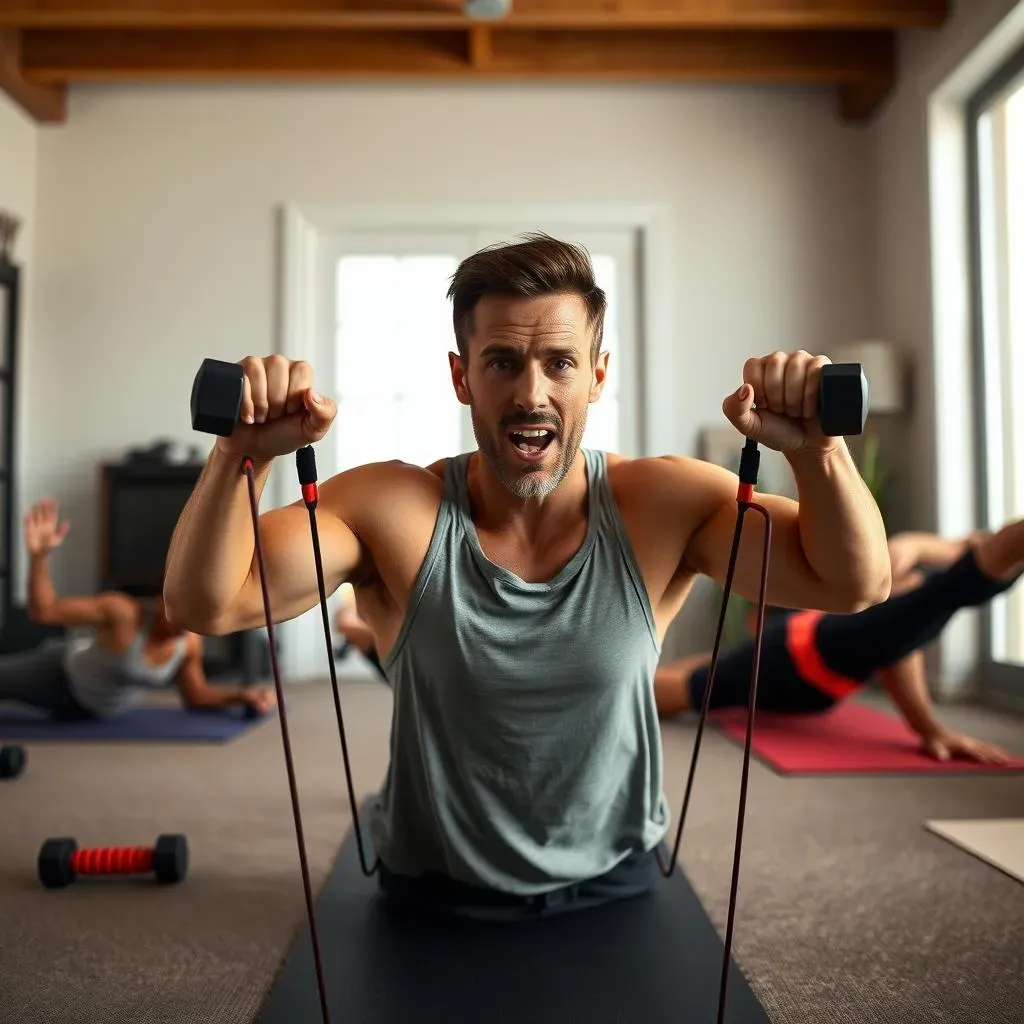Table of Contents
Ready to sculpt a rock-solid core without ever stepping foot in a gym? This article is your ultimate guide to a transformative "full body workout at home for core." We'll move beyond simple ab exercises and explore a holistic approach that strengthens your entire body, building a powerful core as the foundation. Forget boring routines! We'll unleash dynamic movements that challenge your muscles and boost your metabolism. First, we'll dive into effective core-strengthening exercises you can easily perform at home, using only your bodyweight or minimal equipment. Then, we'll explore how full-body movements indirectly engage your core, enhancing stability and strength. Finally, we'll provide advanced techniques and progressions to keep your workouts challenging and exciting. Prepare to experience a new level of fitness, with a strong, defined core as your reward. Get ready to unleash your inner strength!
Full Body Workout at Home: Core Strengthening Exercises

Full Body Workout at Home: Core Strengthening Exercises
Building a Solid Foundation: Essential Core Exercises
Let's kick things off with some fundamental core exercises that you can easily incorporate into your home workout routine. Think of these as the building blocks for a stronger, more stable core. We're not just focusing on superficial six-pack abs; we're aiming for deep core strength that translates to improved posture, balance, and overall fitness. A strong core is the unsung hero of any workout, providing the stability you need to lift heavier, run faster, and move more efficiently. Remember, consistency is key! Start with a few sets of each exercise, gradually increasing the reps and sets as you get stronger.
First up: the plank. This classic exercise targets your entire core, building strength and stability. Aim for holding a plank for 30 seconds, gradually increasing the duration as you improve. Looking for a challenge? Try variations like forearm planks or side planks to really target different muscle groups. Check out this no-equipment workout for more ideas!
Exercise | Sets | Reps/Hold Time |
|---|---|---|
Plank | 3 | 30-60 seconds |
Crunches | 3 | 15-20 |
Leg Raises | 3 | 10-15 |
Next, let's add some dynamic movements that really challenge your core. Think of these as your "power moves," engaging multiple muscle groups simultaneously to build strength and endurance. These exercises are not only great for your core, but they'll also help to build overall strength and improve your cardiovascular fitness. Remember to focus on proper form to maximize results and avoid injury. Don't forget to breathe! Controlled breathing is crucial for maintaining stability and engaging your core effectively.
Mountain climbers are a fantastic way to get your heart rate up while simultaneously strengthening your core. Start with 3 sets of 10-15 reps per leg. As you become fitter, you can increase the reps or try adding variations like jumping mountain climbers. For a more intense workout, incorporate this 30-minute full body routine into your schedule!
- Mountain Climbers
- Bicycle Crunches
- Russian Twists
Building a Stronger Core: Full Body Movements for Home

Building a Stronger Core: Full Body Movements for Home
Squats and Lunges: Core Engagement in Action
Now, let's talk about full-body exercises that secretly work your core like crazy. Think squats and lunges – these aren't just leg exercises; they're total-body powerhouses. Why? Because maintaining balance and stability during these movements requires significant core engagement. Your core muscles act as stabilizers, preventing you from toppling over like a wobbly Jenga tower. This constant stabilization strengthens your deep core muscles, leading to better posture and overall body control. Start with bodyweight squats and lunges, gradually adding weight as you gain strength. Aim for 3 sets of 10-12 reps for each exercise. Remember, proper form is key to prevent injuries and maximize results.
Focusing on controlled movements is crucial. Don't just rush through the reps; instead, concentrate on each movement, feeling the engagement in your core. Visualize your core muscles working hard to keep you steady. As you progress, you can increase the difficulty by adding weight or trying variations such as jump squats or walking lunges. For more ideas on full body workouts, check out our best full body workout at home guide!
- Bodyweight Squats
- Lunges (alternating legs)
- Jump Squats (advanced)
Push-Ups and Planks: Dynamic Core Work
Next up, let's explore how seemingly simple exercises like push-ups and planks become incredibly effective core workouts when done correctly. While these are often associated with upper body strength, they demand intense core stabilization. Think of your core as the anchor that keeps your body aligned and prevents you from collapsing. During a push-up, your core works to maintain a straight line from head to toe, resisting the tendency to sag in the middle. Similarly, planks require constant isometric contraction of your core muscles to sustain the position. This isometric work is excellent for building core endurance and strength.
To maximize core engagement, focus on maintaining a perfectly straight line from head to heels. Squeeze your glutes and brace your core throughout the entire movement. Avoid letting your hips sag or your back arch. You can modify push-ups by doing them against a wall or on your knees if needed. For a more advanced challenge, you can try incline push-ups or decline push-ups. For a comprehensive guide on home workouts, check out our guide on full body workouts for beginners!
Exercise | Sets | Reps/Hold Time |
|---|---|---|
Push-ups | 3 | As many reps as possible (AMRAP) |
Plank | 3 | 30-60 seconds |
Dynamic Movements: Elevating Your Core Game
Let's spice things up with some dynamic movements that really challenge your core's stability and coordination. These exercises go beyond static holds, demanding that your core muscles work in concert with other muscle groups to control movement. Think of burpees, mountain climbers, and medicine ball slams – these are full-body exercises that require significant core engagement to maintain balance and control. These dynamic movements also improve your cardiovascular fitness, making them a great addition to any home workout routine. Remember to focus on controlled movements and proper form to maximize results and avoid injury.
Start with 3 sets of 10-15 repetitions for each exercise. As you get stronger, you can increase the number of repetitions or add variations to increase the intensity. For example, you could try adding a jump to your burpees or using a heavier medicine ball for slams. Don't be afraid to challenge yourself; progress comes from pushing your limits! If you're looking for a more structured program, check out our full body workout for weight loss guide.
- Burpees
- Mountain Climbers
- Medicine Ball Slams (if you have one)
Full Body Workout at Home for Core: Advanced Techniques and Progressions

Full Body Workout at Home for Core: Advanced Techniques and Progressions
Adding Resistance: Level Up Your Core
Once you've mastered the basics, it's time to crank up the intensity! Adding resistance to your core exercises is a fantastic way to challenge your muscles and promote further growth. This doesn't necessarily mean investing in expensive equipment. You can easily incorporate resistance using household items like water bottles, bags of rice, or even sturdy books. Start by adding a small amount of weight and gradually increase it as you get stronger. Remember, proper form is crucial, even with added resistance. Focus on controlled movements and avoid jerky motions to prevent injury.
For example, you can add weight to crunches by holding a light dumbbell or water bottle across your chest. Similarly, you can add weight to leg raises by strapping on ankle weights. For planks, you can try performing them on an elevated surface or by adding a weight plate to your back. Remember to listen to your body and stop if you feel any pain. For more ideas on how to add resistance to your workouts, check out our guide on full body workouts with dumbbells!
Exercise | Resistance |
|---|---|
Crunches | Light dumbbell or water bottle |
Leg Raises | Ankle weights |
Plank | Weight plate on back (advanced) |
Isometric Holds: The Secret to Rock-Solid Core
Isometric exercises, those that involve holding a static position, are absolute game-changers for core strength. They may seem simple, but they're incredibly effective at building endurance and stability. Think of planks, side planks, and hollow body holds – these exercises challenge your core muscles to work continuously without movement. This sustained effort builds incredible strength and endurance, leading to a more resilient and powerful core. Hold each position for as long as you can maintain proper form, gradually increasing the hold time as you improve. Remember, quality over quantity is key.
Incorporate isometric holds into your routine by including them between sets of dynamic movements or as a standalone exercise. Start with shorter hold times and gradually increase them as your strength improves. For a more advanced challenge, you can try variations of these exercises, such as adding leg raises to your plank or incorporating a twist to your side plank. Check out our guide on full body workouts for strength for more advanced exercises!
- Plank (various variations)
- Side Plank (various variations)
- Hollow Body Hold
Progressive Overload: The Key to Continuous Improvement
The secret to long-term progress in any fitness journey lies in progressive overload – continually challenging your muscles by gradually increasing the intensity of your workouts. This can involve increasing the number of repetitions, sets, or the amount of weight you lift. It can also involve progressing to more challenging variations of exercises. For example, you could progress from regular planks to forearm planks, or from regular crunches to bicycle crunches. The key is to consistently push yourself just beyond your comfort zone, forcing your muscles to adapt and grow stronger.
Don't be afraid to experiment with different progressions and find what works best for you. Keep track of your progress and make adjustments as needed. Remember, consistency is key. Regularly challenging your muscles is crucial for continuous improvement. If you are looking for a program to help you track your progress, check out our guide on full body workout PDF!
